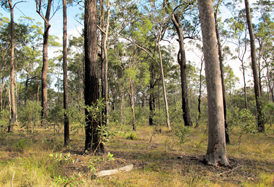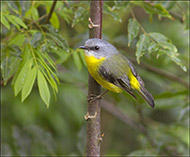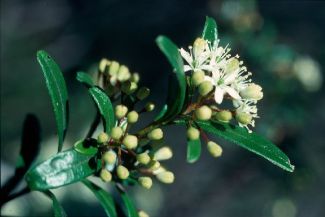Description

What are they?
Open-forest is a vegetation type with moderately tall trees and a reasonably open canopy that lets in some light. The ground layer can be grassy or shrubby.
Forests tend to be named after their dominant canopy trees, so eucalypts are the most common canopy trees in eucalypt open-forests.
In these web pages, the term eucalypt includes species of Eucalyptus, Corymbia (also known as bloodwoods) and Angophora. Eucalypt open-forests are also known as dry sclerophyll forests.
Where are they?
Eucalypt open-forests occur over a large area of eastern Queensland, from the New South Wales border to Cape York Peninsula. They are mostly found between the wet sclerophyll forests of high rainfall areas, and the eucalypt woodlands of the drier interior.
Carbon potential
The above-ground parts of woody plants in eucalypt open-forests can hold about 86 to 860 tonnes of carbon dioxide equivalent per hectare.
Regrowing eucalypt open-forests will capture atmospheric carbon and store it in woody plant tissues. The peak carbon accumulation rate is likely to range from 2 to more than 17 tonnes of carbon dioxide equivalent per hectare per year.
Read more about farming carbon and limits to carbon accumulation.
Restoration and management


Rainfall and past clearing history have a large influence on the potential for reforestation and carbon accumulation in eucalypt open-forests, but ongoing management is also important.
Continuous high grazing pressure, clearing and hot fires will slow and may prevent the restoration of eucalypt open-forests, as these will inhibit tree establishment and growth.
Livestock grazing can be compatible with reforestation in eucalypt open-forests, as long as grazing pressure is held at low to moderate levels, and there is enough strategic spelling (periods where grazing is stopped) to allow new trees to establish.
In general, increasing the biomass of trees will reduce the carrying capacity for grazing.
Timber harvesting can be compatible with reforestation in eucalypt open-forests, although it will slow the rate of carbon accumulation and reduce carbon stocks in the short term.
Wildlife
Regrowing eucalypt open-forests will benefit wildlife, especially animals such as birds, reptiles and mammals that rely on eucalypt open-forests for habitat.
More information
View the Eucalypt open-forest Management Guideline


